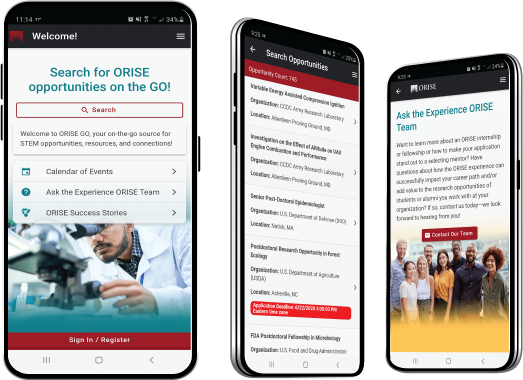EPA Fellowship on Optimizing Wetland Restoration Placement for Nutrient Interception and Removal
-
An application
-
Transcript(s) – For this opportunity, an unofficial transcript or copy of the student academic records printed by the applicant or by academic advisors from internal institution systems may be submitted. All transcripts must be in English or include an official English translation. Click here for detailed information about acceptable transcripts.
-
A current resume/CV, including academic history, employment history, relevant experiences, and publication list
-
Two educational or professional recommendations. Click here for detailed information about recommendations.
*Applications may be reviewed on a rolling-basis and this posting could close before the deadline. Click here for information about the selection process.
EPA Office/Lab and Location: A research opportunity is available at the Environmental Protection Agency (EPA), Office of Research and Development (ORD), Center for Public Health and Environmental Assessment (CPHEA), Pacific Ecological Systems Division (PESD) in Corvallis, Oregon.
Research Project: Wetland restoration is an important strategy to reduce the release of excess nutrients to the environment, including downstream rivers, streams, and lakes. While restoration can be an effective tool for reducing excess nutrient release, the placement of wetlands on the landscape relative to nutrient sources, other wetlands, and receiving waters is important for effective management. This research will refine the tools we use to optimize the placement of restorable wetlands within watersheds to maximize nutrient interception and potential reduction at the national scale.
This research opportunity with EPA will leverage recently developed geospatial methods and datasets (Leibowitz et al. 2023) to hydrologically link several million existing and potentially-restorable wetlands to upslope nutrient sources and downstream waters. Specifically, this research will bring together EPA and other federal geospatial datasets of existing wetlands, potentially-restorable wetlands (https://rb.gy/bd0), stream and/or lake network hydrology (StreamCat/LakeCat), and landscape nutrient inventories into a connected framework that will allow for optimization of wetland restoration scenarios within several million watersheds of the conterminous US. Additional effort could join these data with long-term nutrient monitoring data to improve our understanding of nutrient interception and reduction through process-based (e.g., SWAT) or statistical modeling at large spatial extents.
Under the guidance of a mentor, the research activities may include:
- Application and updating of a novel geospatial framework for wetland connectivity to a dataset of potentially-restorable wetlands.
- Using this framework to identify opportunities for nutrient removal within millions of wetland basins and routing this information to several million downstream rivers, streams, and/or lakes.
- Using output from this framework to develop a wetland restoration prioritization schema for watersheds across the conterminous US to support national nutrient reduction efforts.
- Developing quality assurance and model evaluation approaches for assessing outcomes derived from this framework.
- Interacting with EPA scientists across the Agency on related national mapping activities.
- Conducting scientific synthesis, data analysis, manuscript preparation and literature searches.
Leibowitz, S. G., R. A. Hill, I. F. Creed, J. E. Compton, H. E. Golden, M. H. Weber, M. C. Rains, C. E. Jones, E. H. Lee, J. R. Christensen, R. A. Bellmore, and C. R. Lane. 2023. National hydrologic connectivity classification links wetlands with stream water quality. Nature Water. https://doi.org/10.1038/s44221-023-00057-w.
Learning Objectives: The research participant will be mentored by EPA scientist Ryan Hill with opportunities for close collaborations with EPA scientists as part of a national EPA program on managing excess nutrient releases to the environment within EPA’s Safe and Sustainable Water Research Program. The research participant will have the opportunity to learn about EPA's research program on the impacts of watershed management on water pollution, to conduct research on national geospatial data sets, to apply watershed analyses and aquatic data to address EPA science needs, and to publish and present their research to the broader scientific community.
Mentor(s): The mentor for this project is Dr. Ryan Hill (hill.ryan@epa.gov) at the EPA’s Pacific Ecological Systems Division. If you have questions about the nature of the research please contact the mentor(s).
Anticipated Appointment Start Date: August 1, 2023. All start dates are flexible and vary depending on numerous factors. Click here for detailed information about start dates.
Appointment Length: The appointment will initially be for one year and may be renewed upon EPA recommendation and subject to availability of funding.
Level of Participation: The appointment is full-time.
Participant Stipend: The participant will receive a monthly stipend commensurate with educational level and experience. Click here for detailed information about full-time stipends.
EPA Security Clearance: Completion of a successful background investigation by the Office of Personnel Management (OPM) is required for an applicant to be on-boarded at EPA.
ORISE Information: This program, administered by ORAU through its contract with the U.S. Department of Energy (DOE) to manage the Oak Ridge Institute for Science and Education (ORISE), was established through an interagency agreement between DOE and EPA. Participants do not become employees of EPA, DOE or the program administrator, and there are no employment-related benefits. Proof of health insurance is required for participation in this program. Health insurance can be obtained through ORISE.
ORISE offers all ORISE EPA graduate students and Postdocs a free 5 year membership to the National Postdoctoral Association (NPA).
The successful applicant(s) will be required to comply with Environmental, Safety and Health (ES&H) requirements of the hosting facility, including but not limited to, COVID-19 requirements (e.g. facial covering, physical distancing, testing, vaccination).
Questions: Please see the FAQ section of our website. After reading, if you have additional questions about the application process please email ORISE.EPA.ORD@orau.org and include the reference code for this opportunity.
The qualified candidate should have received a doctoral degree in one of the relevant fields, or be currently pursuing the degree with completion before August 4, 2023. Degree must have been received within five years of the appointment start date.
- PhD in wetland ecology, biogeochemistry, or landscape analysis of aquatic systems with a strong background in geospatial analysis, statistical methods, or process-based modeling (e.g., SWAT) of water quality data.
- Strong background in wetland ecology, biogeochemistry, or landscape analysis of aquatic systems.
- Strong background in geospatial analysis, statistical methods, or process-based modeling (e.g., SWAT) of water quality data.
- Excellent written verbal and written communication skills.
- Demonstrated skills working in a group setting.
- Experience working in ArcGIS and coding in Python or R.
- Experience working with watershed (e.g., National Hydrography Dataset Plus) or water quality data (e.g., physical, chemical, or biological).
- Citizenship: U.S. Citizen Only
- Degree: Doctoral Degree received within the last 60 months or anticipated to be received by 8/4/2023 11:59:00 PM.
-
Discipline(s):
- Chemistry and Materials Sciences (8 )
- Communications and Graphics Design (1 )
- Computer, Information, and Data Sciences (2 )
- Earth and Geosciences (8 )
- Engineering (7 )
- Environmental and Marine Sciences (14 )
- Life Health and Medical Sciences (20 )
- Mathematics and Statistics (1 )
- Other Non-Science & Engineering (1 )
- Physics (3 )
- Social and Behavioral Sciences (3 )

 ORISE GO
ORISE GO

The ORISE GO mobile app helps you stay engaged, connected and informed during your ORISE experience – from application, to offer, through your appointment and even as an ORISE alum!





